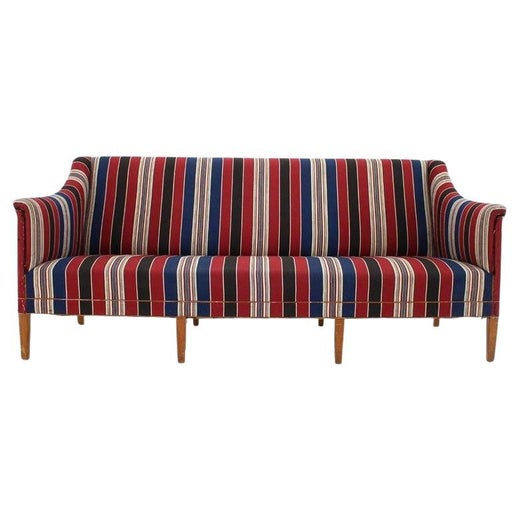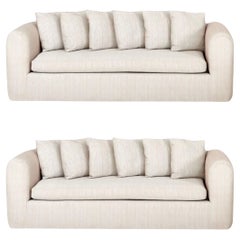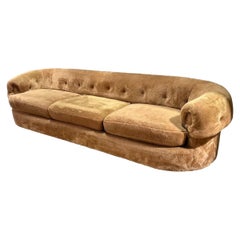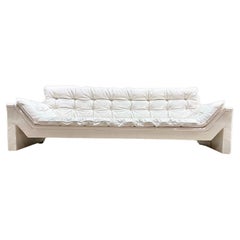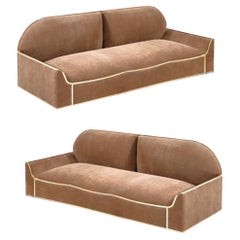Kaare Klint Sofa Model 5011, Denmark, 1930s
About the Item
- Creator:Kaare Klint (Designer)
- Dimensions:Height: 36 in (91.44 cm)Width: 76 in (193.04 cm)Depth: 31 in (78.74 cm)Seat Height: 16 in (40.64 cm)
- Style:Mid-Century Modern (Of the Period)
- Materials and Techniques:
- Place of Origin:
- Period:
- Date of Manufacture:1930s
- Condition:Wear consistent with age and use.
- Seller Location:Chicago, IL
- Reference Number:Seller: 2019131stDibs: LU918713381001
Kaare Klint
Architect, teacher and furniture designer Kaare Klint is among the most important figures in Scandinavian modernism. Widely recognized as the father of modern Danish furniture, Klint sought to pay homage to historical furniture styles and prized functionality as essential to designing for modern living. He established the design school at Copenhagen’s Royal Danish Academy of Fine Arts, and his students became mid-century legends of cabinetry and furniture-making.
Klint prioritized functionalism and drew on an array of influences in his own work. Furniture experts will observe the influence of 18th-century English seating in his Red chair, while Klint’s iconic Safari chair had roots in campaign furniture. The other exemplary chairs, sofas and tables for which he is known bear the mark of Thomas Chippendale and Biedermeier furniture as well as Greek and Roman forms.
Klint's father was Peder Vilhelm Jensen-Klint, a formidable architect of his day. The younger Klint initially followed in his father’s footsteps, studying under him as well as distinguished architect Carl Petersen. Alongside Danish architect Ivar Bentsen, he headed the renovation of the Designmuseum Denmark in Copenhagen from 1920–26 (Klint also furnished the institution as part of the project). Around the same time, Klint helped found the furniture design school at the Royal Danish Academy. The impact of his role as an instructor there cannot be overstated — he mentored such esteemed cabinetmakers and furniture designers as Børge Mogensen, Hans Wegner and Ole Wanscher.
A prominent advocate of ergonomics, Klint valued comfort and functionality over style. Painstaking research went into each piece of sophisticated yet wholly unadorned furniture he designed, as he endeavored to build structures that took into consideration human proportions and scale. And like the Shakers, Klint believed that quality craftsmanship and good materials were integral to the design of durable furniture that was free of embellishment.
The humble grace of Klint’s style characterizes legendary seating designs that continue to charm today’s legions of mid-century modern enthusiasts. His Safari chair, Faaborg chair, Ravenna armchair and Propeller stool — as well as most of the seating created by Danish modernists generally — have warmed interiors and influenced furniture designers all over the world.
Find vintage Kaare Klint furniture and other Scandinavian modern furniture on 1stDibs.
You May Also Like
Vintage 1930s Danish Sofas
Leather
Vintage 1970s Danish Scandinavian Modern Sofas
Leather, Ash
Vintage 1940s Danish Scandinavian Modern Sofas
Leather, Mahogany
Mid-20th Century Danish Mid-Century Modern Sofas
Mahogany, Leather
Vintage 1930s Danish Scandinavian Modern Sofas
Leather, Mahogany
Vintage 1960s Danish Scandinavian Modern Sofas
Wool
Vintage 1940s Danish Mid-Century Modern Sofas
Fabric, Wood, Textile, Upholstery
Vintage 1940s Danish Scandinavian Modern Sofas
Upholstery, Mahogany
Mid-20th Century Danish Scandinavian Modern Sofas
Mahogany
Mid-20th Century Danish Scandinavian Modern Sofas
Mahogany, Fabric
More From This Seller
View AllVintage 1970s American Mid-Century Modern Sofas
Silk
Vintage 1970s American Mid-Century Modern Sofas
Velvet
Vintage 1960s American Mid-Century Modern Sofas
Naugahyde
Vintage 1960s American Mid-Century Modern Sofas
Brass
Vintage 1960s British Mid-Century Modern Sofas
Stainless Steel
Vintage 1970s American Mid-Century Modern Sofas
Leather
